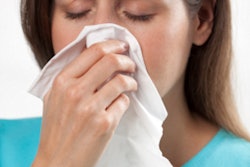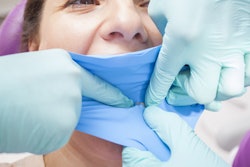
With cold season comes an increased need for infection control, and a new study could help protect the health of practitioners and their staff from infectious agents found in the mouths of patients.
In the study, researchers from the pediatric dentistry department at the University of Nevada, Las Vegas (UNLV) School of Dental Medicine found that using the Isolite system or a dental dam with high-volume evacuation (HVE) resulted in significantly less spatter than using HVE alone (Journal of the American Dental Association, November 2012, Vol. 143:11, pp. 1199-1204).
Hard-tissue preparation with handpieces and ultrasonic scalers results mostly in large-particle spatter, which settles on surrounding surfaces, the study authors noted. This can result in contamination issues with transmissible forms of tuberculosis, influenza, Legionnaires' disease, and severe acute respiratory syndrome. The effectiveness of dental dams has been established by previous research, while other studies found that an HVE is able to limit the amount of aerosol and spatter emanating from a dental procedural site by 90%.
"We wanted to compare the effectiveness of two dry-field isolation techniques with a control (no isolation) in reducing spatter from a dental operative site," Richard Walker, DDS, a professor of clinical sciences at UNLV's School of Dental Medicine who participated in the study wrote in an email to DrBicuspid. " The results of the study showed that use of a dental dam and HVE or with the Isolite system significantly reduced spatter overall compared with use of HVE alone."
Documenting spatter pattern
To prepare for the benchtop experiment, the researchers covered vents in the operatory so that they did not impact the spatter pattern. A typodont manikin head was situated in the headrest of a dental chair and the oral cavity surrounded by a 4 x 3-inch platform covered with paper. Next, they used clamps to secure an HVE and a high-speed dental handpiece (INTRAmatic Lux 3 25LHA, KaVo Dental) in the manikin's mouth, simulating the position of a right-handed dentist who is preparing three posterior teeth.
The handpiece's water flow was set at 25 mL per minute. During both the first experimental and control trials, the orifice of the HVE was placed 1 cm from the tooth undergoing preparation.
Preparation was simulated on teeth Nos. 18, 19, and 20 in all three procedures, eight times each, for a total of 72 trials (effect size = 0.20; p < 0.05). A bite block and the HVE were in place during control testing. In the first experimental setting, teeth were prepared with a bite block, dental dam, and the HVE in place. For the second experimental setting, an Isolite system was placed in the manikin's mouth and set at maximum strength.
The water used in the study was blended with dye for easier viewing, and after each trial the researchers removed and examined the paper covering the surface of the wooden platform. They gridded the paper and examined it for signs of spatter. One or more spots found within a 5-cm2 grid square qualified that particular square on the paper as contaminated. They then tallied the number of contaminated squares per trial and analyzed the results.
Limiting contamination
The researchers found, overall, no statistically significant difference between the two dry-field techniques in the amount of spatter reduction. They also found that the two techniques were similarly effective when performing procedures where mandibular posterior permanent teeth were involved.
However, they found significantly more spatter reduction using a dental dam and HVE than with the Isolite system when they prepared tooth No. 20 with each technique in their trials, compared with Nos. 18 and 19.
"The two-way ANOVA [analysis of variance] showed statistically significant differences in the amount of spatter produced between the control, dental dam, and Isolite groups (p < 0.001), in the amount of spatter produced between teeth numbers 18, 19, and 20 (p < 0.003), and in the interaction between the isolation method and the tooth number (p < 0.001)," the researchers wrote. They also noted significantly less spatter in the experimental trials and no statistical significant difference between isolation methods.
The researchers observed some disparities in the performance of each spatter-control method on each tooth. On 18, the experimental methods equally outperformed the control. On 19, spatter reduction with the dental dam was significant but not when the Isolite system was used (p < 0.056). "Yet, there was no significant difference between the dental dam and the Isolite device for tooth number 19," the study authors wrote.
For tooth 20, there was a statistically significant reduction in spatter for both experimental methods, but there was significantly more reduction with the dental dam than with the Isolite device (p < 0.001). The researchers attributed the better performance of the dental dam and HVE over the Isolite system in this situation to the design of the latter.
Gingival tissue exposed
The researchers noted the Isolite system's myriad features, such as isolation, high-speed evacuation, and protection of adjacent soft tissues, and ease of use in their report. The system also enables procedures that may be hindered by access problems presented by a dental dam.
But they also observed that the Isolite leaves some of the gingival tissue exposed while a dental dam is inverted into the gingival sulcus. "The bacterial content of the aerosol and spatter produced when using the Isolite device may be higher or more diverse than that produced when using the dental dam with HVE," they wrote.
"This study focused on the amount of spatter, not the amount of pathogens in the spatter," Dr. Walker noted. "Therefore, no conclusions can be made concerning the amount of microbial contamination between the different methods. Our in vitro set-up showed that the two dry field isolation techniques reduced the amount of spatter compared to the control (no isolation). Further in vivo study measuring microbial contamination will be necessary to determine the potential for reduction of communicable disease transmission."
The researchers acknowledged Isolite Systems as a financial supporter of the study.



















